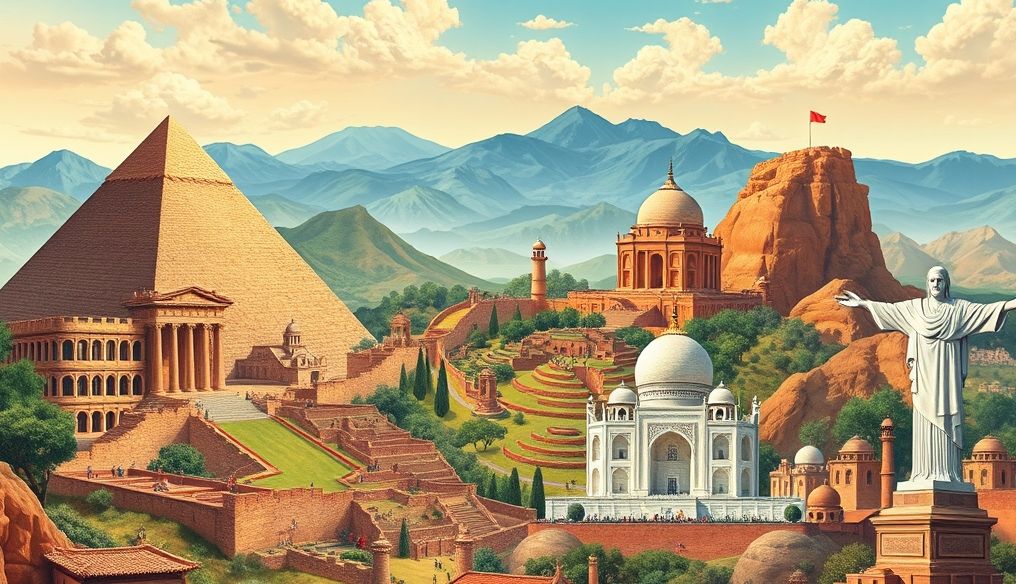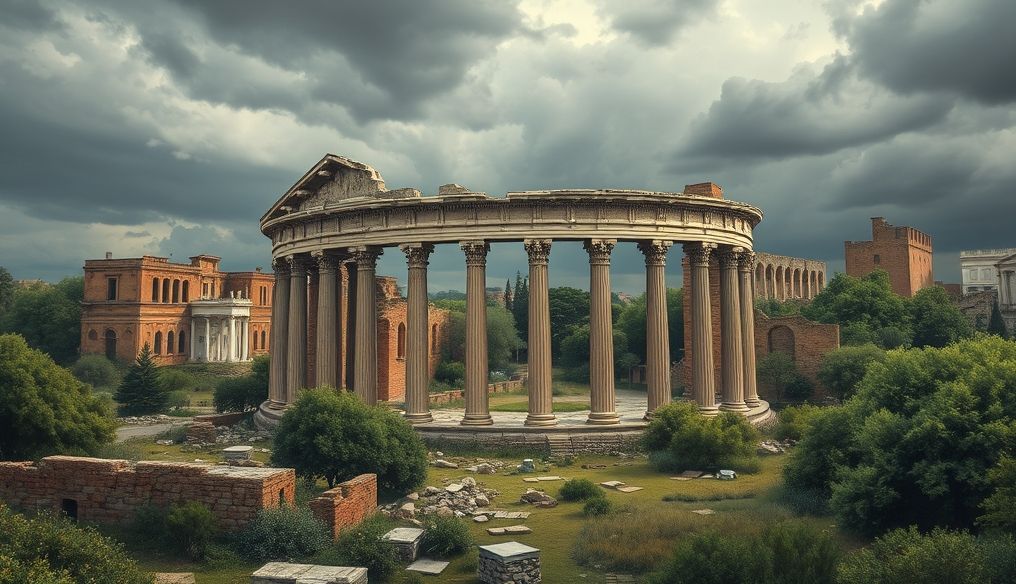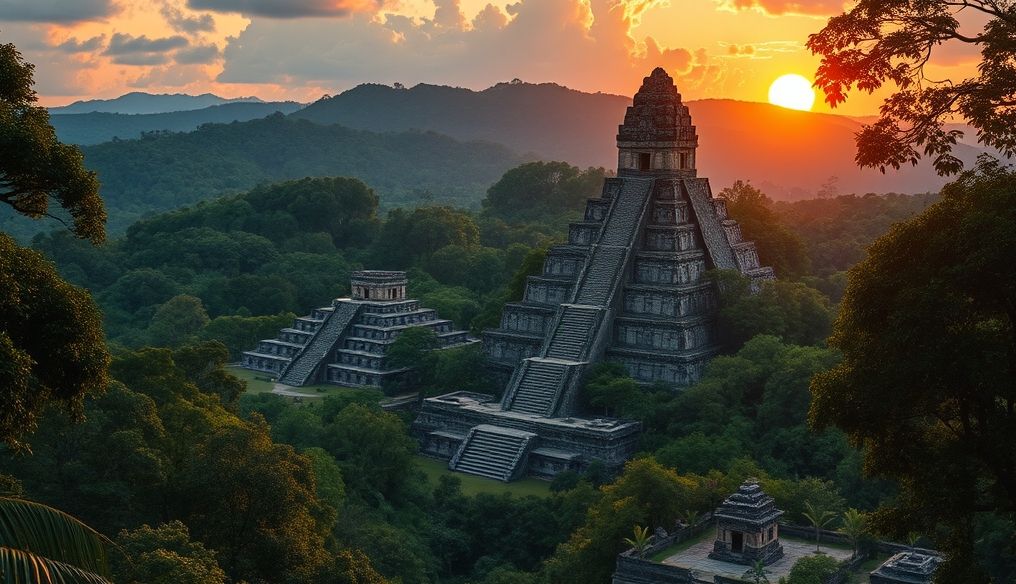What are the Seven Wonders of the Ancient and Modern Worlds and What Distinguishes Them?
The Seven Wonders of the Ancient and Modern Worlds have long captivated human imagination, representing the pinnacle of human creativity and architectural marvels that have either stood the test of time or left an indelible mark on history. This list, which has evolved over time, reflects diverse cultural and architectural values, and embodies the aspirations of ancient and contemporary civilizations.
The Seven Wonders of the Ancient World: A Look into the Past
The list of the Seven Wonders of the Ancient World was compiled in the Hellenistic period, and includes impressive architectural and engineering landmarks. Unfortunately, only the Great Pyramid of Giza remains, while the rest have disappeared due to earthquakes, wars, or the ravages of time. Here's a detailed look:
1. Great Pyramid of Giza: A Witness to the Greatness of the Pharaohs
The Great Pyramid of Giza is the only remaining of the Seven Wonders of the Ancient World. Built during the reign of Pharaoh Khufu, it is an amazing engineering masterpiece. It consists of millions of huge stones, and still raises questions about how it was built with such precision in that era.
Basic Information:
- Location: Giza, Egypt
- Construction Date: Around 2580-2560 BC
- Purpose: Tomb for Pharaoh Khufu
2. Hanging Gardens of Babylon: A Legend of Beauty and Irrigation
The Hanging Gardens of Babylon are considered one of the most mysterious wonders, with some doubting their actual existence. It is said that they were built in the city of Babylon (present-day Iraq) by order of King Nebuchadnezzar II for his wife. They were described as a series of elevated agricultural terraces, decorated with diverse plants and trees.
Basic Information (Hypothetical):
- Location: Babylon, Iraq (Alleged)
- Construction Date: Around 600 BC (Alleged)
- Purpose: Gift from King Nebuchadnezzar II to his wife
3. Statue of Zeus at Olympia: A Huge Work of Art
The Statue of Zeus at Olympia was a huge statue of the god Zeus, made of ivory and gold, located in the Temple of Zeus in Olympia, Greece. It was considered one of the greatest statues in the ancient world.
Basic Information:
- Location: Olympia, Greece
- Construction Date: Around 435 BC
- Material: Ivory and Gold
4. Temple of Artemis at Ephesus: Honoring the Goddess
The Temple of Artemis at Ephesus (present-day Turkey) was a huge temple dedicated to the goddess Artemis. It was destroyed and rebuilt several times, and was considered one of the most beautiful buildings in the ancient world.
Basic Information:
- Location: Ephesus, Turkey
- Construction Date: Several phases, starting in the 8th century BC
- Purpose: Temple to the goddess Artemis
5. Mausoleum at Halicarnassus: A Luxurious Royal Tomb
The Mausoleum at Halicarnassus (present-day Turkey) was a luxurious tomb for King Mausolus, the ruler of Caria. It was characterized by its unique architectural design, which combined Greek, Egyptian, and Eastern styles.
Basic Information:
- Location: Halicarnassus, Turkey
- Construction Date: Around 351 BC
- Purpose: Tomb for King Mausolus
6. Colossus of Rhodes: Symbol of the Sun and Freedom
The Colossus of Rhodes was a huge statue of the god Helios, the god of the sun, located in the city of Rhodes, Greece. It was considered one of the tallest statues in the ancient world, and collapsed due to an earthquake.
Basic Information:
- Location: Rhodes, Greece
- Construction Date: Around 292-280 BC
- Purpose: Statue of the god Helios
7. Lighthouse of Alexandria: Guide for Sailors and Light of Knowledge
The Lighthouse of Alexandria was a huge lighthouse located in the city of Alexandria, Egypt. It was used to guide ships, and was considered one of the tallest man-made structures in the ancient world. It collapsed due to earthquakes.
Basic Information:
- Location: Alexandria, Egypt
- Construction Date: 3rd century BC
- Purpose: Guiding Ships
The New Seven Wonders of the World: Honoring Contemporary Creativity
In 2007, a new list of the Seven Wonders of the World was selected through a global vote. This list aims to honor contemporary architectural and engineering creativity, and reflects the cultural and geographical diversity of the world.
1. Great Wall of China: Symbol of Unity and Defense
The Great Wall of China is a series of defensive fortifications built over the ages to protect China from invaders. It stretches for thousands of kilometers, and is considered a symbol of Chinese unity and strength.
Basic Information:
- Location: China
- Construction Date: Began in the 7th century BC, and continued for centuries
- Purpose: Defensive fortification
2. Petra: An Architectural Masterpiece Carved in Rock
Petra is an archaeological city located in Jordan, and is famous for its architectural landmarks carved in sandstone rock. It was the capital of the Nabataean kingdom, and is considered a unique work of art.
Basic Information:
- Location: Jordan
- Construction Date: 4th century BC
- Purpose: Capital of the Nabataean kingdom
3. Christ the Redeemer in Rio de Janeiro: Symbol of Faith and Hope
Christ the Redeemer is a huge statue of Jesus Christ located on the summit of Corcovado Mountain in Rio de Janeiro, Brazil. It is considered a symbol of faith and hope, and overlooks the city with a breathtaking panoramic view.
Basic Information:
- Location: Rio de Janeiro, Brazil
- Construction Date: 1931
- Purpose: Religious symbol
4. Machu Picchu: Pearl of the Inca Civilization
Machu Picchu is an archaeological city located in the Andes Mountains in Peru. It was a sacred city for the Inca civilization, and is characterized by its stunning architectural landmarks and strategic location.
Basic Information:
- Location: Peru
- Construction Date: 15th century AD
- Purpose: Sacred city of the Inca civilization
5. Chichen Itza: Center of the Mayan Civilization
Chichen Itza is an archaeological city located in the Yucatan Peninsula in Mexico. It was an important cultural center for the Mayan civilization, and is famous for the stepped pyramid of Kukulcan.
Basic Information:
- Location: Mexico
- Construction Date: 6th century AD
- Purpose: Cultural center of the Mayan civilization
6. Colosseum in Rome: Arena for Battles and Entertainment
The Colosseum is a huge Roman amphitheater located in Rome, Italy. It was used to host gladiator fights and public entertainment shows.
Basic Information:
- Location: Rome, Italy
- Construction Date: 1st century AD
- Purpose: Arena for battles and entertainment
7. Taj Mahal: A Timeless Love Story
The Taj Mahal is a white marble mausoleum located in Agra, India. It was built by order of the Mughal Emperor Shah Jahan in memory of his wife Mumtaz Mahal, and is considered a symbol of eternal love.
Basic Information:
- Location: Agra, India
- Construction Date: 17th century AD
- Purpose: Memorial mausoleum
Conclusion: A Legacy of Human Creativity
The Seven Wonders of the Ancient and Modern Worlds represent a testament to human ability to create and innovate. Whether they are monuments that have stood for thousands of years or modern architectural masterpieces, these landmarks inspire awe and admiration, and remind us of the importance of preserving our cultural heritage.
Comparison Table Between the Seven Wonders of the Ancient and Modern Worlds:
| Seven Wonders of the Ancient World | Seven Wonders of the Modern World |
|---|---|
| Great Pyramid of Giza | Great Wall of China |
| Hanging Gardens of Babylon | Petra |
| Statue of Zeus at Olympia | Christ the Redeemer |
| Temple of Artemis at Ephesus | Machu Picchu |
| Mausoleum at Halicarnassus | Chichen Itza |
| Colossus of Rhodes | Colosseum |
| Lighthouse of Alexandria | Taj Mahal |
"The Seven Wonders, ancient and modern, are a testament to human ambition and the ability to achieve the impossible."




